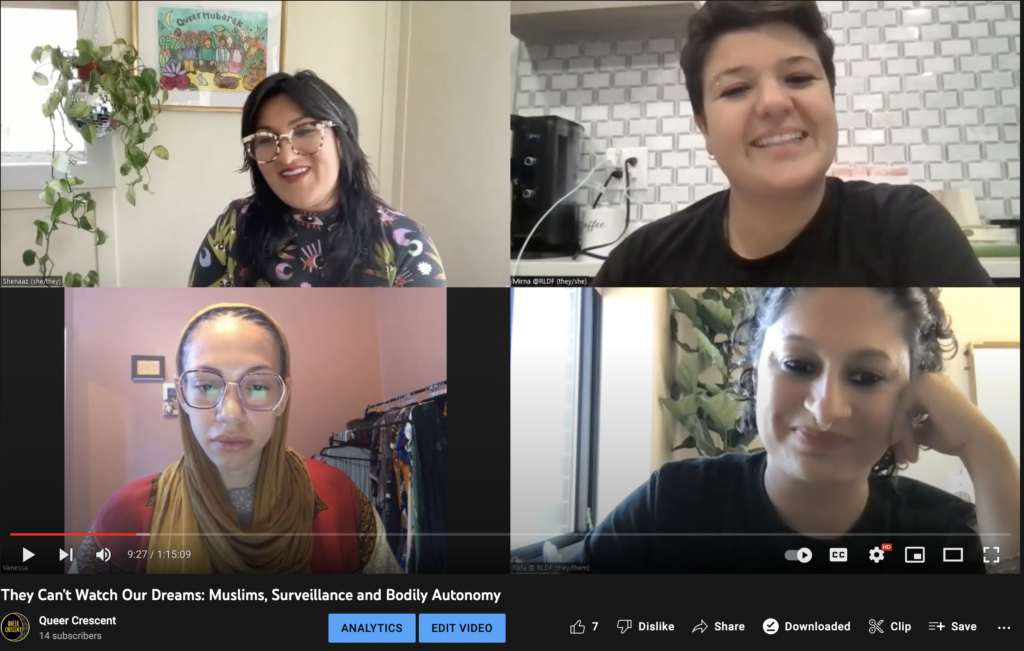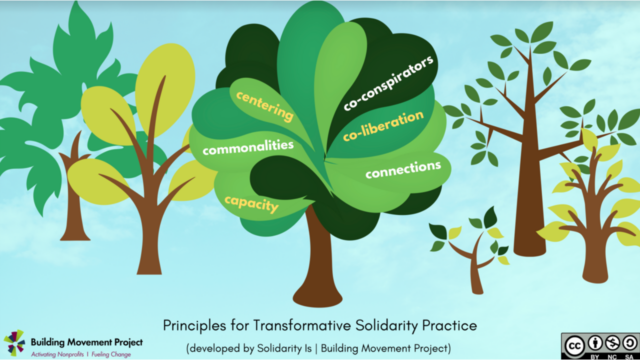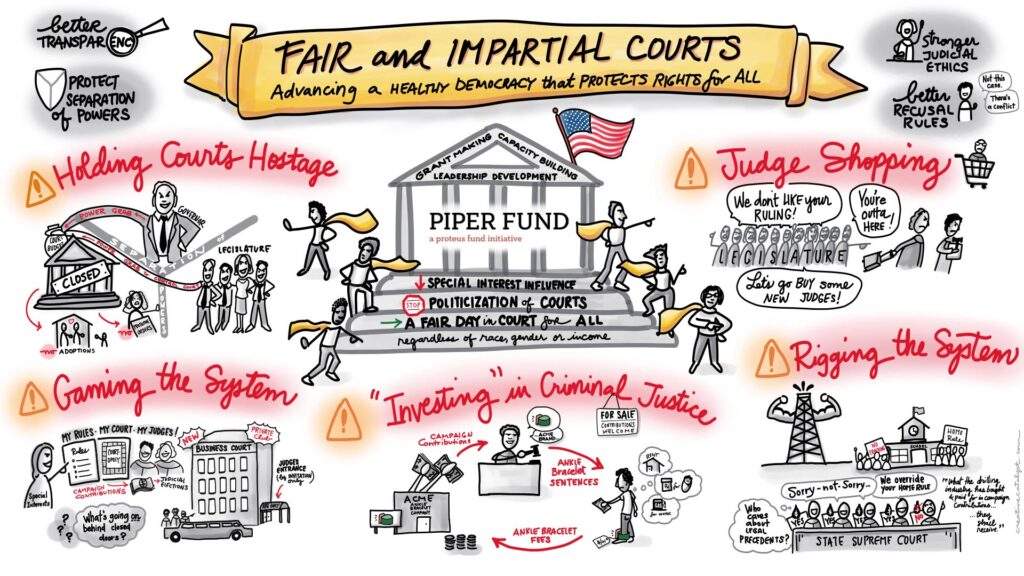Proteus Fund’s October 2022 Newsletter
At some point in the last six years, we’ve probably all said to ourselves: “how could we possibly get to where we are now in this country?” Even for those who have supported and worked for many years towards a vision of an inclusive, just society, the totality of what has happened has been shocking. To move forward, we must put the shock behind us. For funders to play an effective role in changing the current trajectory of this country, we need to deeply and comprehensively analyze exactly how anti-justice and anti-democracy forces brought us to this point. If we don’t, we run a great risk that our funding partnerships with grantees will amount to little more than a game of whack-a-mole.
Of course, we know that these ideologies and the forces behind them did not spring up from out of nowhere in the past 6-10 years. But mainstream (some might say “liberal”) history and political science generally have been too quick to conclude the path towards a more just society has been one of linear progress with occasional detours. Through this lens, one can be led to conclude that long-lived reactionary forces, such as the Klu Klux Klan, were effectively sidelined decades ago. Fascism died with WWII. And, well-known, highly influential, ultra-conservative organizations, like the John Birch Society, peaked in their influence in the 1970s.
But as a growing body of historical and political analyses* shows, belief systems based on toxic views around race, gender, colonialism, and democracy were not only never completely buried, but were simply re-adjusting and re-tooling. In fact, it’s now clearer than ever that movements based on these corrosive ideologies began coalescing in new and different ways at the very same time that the civil rights movement was at its zenith in this country.
Increasingly organized, well-funded efforts to dramatically reverse social and economic progress have been evolving and growing stronger at a steady pace over the last 60 years. Not just a thread, but a rope pulls together the John Birch Society (founded in 1958), the Moral Majority (founded in 1979), the Tea Party (2009), and the morphing of more traditional evangelical thought into the movement for White Christian Evangelical nationalism. Toss in the resources of the Koch family and other uber-wealthy individuals like them, and we arrive at the society we are living in today.
What we see now is the alignment of efforts to “reform” democracy with monied elites’ white supremacy, evangelical Christian nationalism into a highly successful, radical meta-movement. True to the organizing principle of deep collaboration, each branch of this movement proactively supports the agenda of the other branches. This in turn creates the oxygen needed for even more radical ideas and behavior, like armed militia, to thrive. The tipping point we have reached now is that this specific evolution and cross-pollination has brought these extremes into the mainstream.
If this sounds familiar, think about some of the major challenges pro-justice, equality, and democracy funders (and organizations on the ground) continue to grapple with around breaking out of silos and achieving intersectionality. The radical forces we are pushing back against today found intersectionality and successful strategies to rise above siloed tactics (and funding streams) before we did. And, they have effectively taken both approaches much further than we have.
The question and the challenge we are faced with at this moment is whether foundation and individual donors can ground their work in more accurate and insightful historical and political analyses while figuring out – quickly – ways to make similar strategic progress so that we can effectively work with our partners to realize the world we desire before that vision is completely out of reach.
— Paul
*Nancy MacLean’s Democracy in Chains: The Deep History of the Radical Right’s Stealth Plan for America and Bradley Onishi’s upcoming Preparing for War: The Extremist History of White Christian Nationalism are contributions to this new line of analysis.

The Dobbs v. Jackson Women’s Health ruling has again put reproductive justice at the center of the national conversation, but as is too often the case, that conversation has largely failed to acknowledge the intersectional impact for certain groups which are now experiencing assaults on bodily autonomy on multiple levels, such as LGBTQ Muslims. In the more than 20 years since 9/11, state-sanctioned surveillance of Muslim communities has occurred across the country. Now, with abortion bans being imposed in multiple states, there are looming threats of use of surveillance to criminalize people capable of pregnancy seeking information about abortion services.
Fortunately, there are organizations like Queer Crescent, an RTF grantee that centers its work on community, culture, safety, and healing arts for LGBTQ Muslims. Both RTF and the Rights, Faith and Democracy Collaborative (RFDC) are providing Queer Crescent with rapid response funds to support the development of a network of Muslim healers. Funds will be used to help the cohort of Muslim healers receive training, skills, and support in providing gender-affirming care and connect that to access to broader struggles for bodily autonomy, and gender justice. Queer Crescent has a goal of scaling up to 25 Muslim healers and connecting them so they are less isolated, and to promote expansive reproductive justice conversations in Muslim communities that connect abortion care and reproductive care to gender-affirming care.
“Queer Crescent sees reproductive justice as bodily autonomy and resisting the intersecting struggles our communities face,” says Shenaaz Janmohamed, the organization’s executive director. “We affirm that bodily autonomy is about living with dignity and safety, from housing to jobs, clean water, being in the right relationship to the environment, and of course reproductive healthcare – including abortion access, gender-affirming care, parenting support, childcare and more.”
Just last month, Queer Crescent launched the Muslim Fund for Bodily Autonomy, a mutual aid program designed to provide resource connection, cash assistance, and community to Muslims most impacted by abortion restrictions and bans. In six weeks, Queer Crescent has received more than 110 applicants, primarily residing in the U.S. Southern States and the Midwest, facing hardships in accessing mental healthcare, reproductive healthcare, and gender-affirming healthcare.
Over the past year, the Proteus Fund has been working with grassroots organizations and philanthropic leaders to better center and ultimately support “solidarity’ as a value and strategy for moving towards an inclusive, representative democracy. While many conceptually support the idea of solidarity, many fairly ask what solidarity really means in practice? This question and answer with Deepa Iyer, who is one of the foremost practitioners and teachers on solidarity, attempts to answer these and other questions.

Solidarity, to some extent, is becoming a buzzword in social justice spaces. Based on your over 10 years of experience promoting solidarity as a strategy and value, what characterizes authentic and impactful solidarity? In your experience, what does solidarity look like in social justice work concretely?
Solidarity is often perceived as short-lived and reactionary actions responding to a crisis moment. My work with coalitions and networks has led me to understand that solidarity is a set of practices grounded in trust and motivated by meaningful connections to others.
At SolidarityIs and Building Movement Project (BMP), we invite people and organizations to imagine solidarity as a set of practices. For example, practicing solidarity means that we center the needs and demands of those affected by inequity and injustice, even if we might not fully understand or even agree. It means that we think of ourselves not merely as allies but as thoughtful and accountable co-conspirators who show up time and again, who take risks, and who use our privilege and power for the common good. It means that we look for commonalities and connections between communities and issues without flattening, comparing, or equalizing them. And it means that we build our capacity as individuals and organizations to take the time to build relationships and foster trust, the cornerstones of solidarity practice. When we are more intentional about how we practice solidarity, we can move from a transactional to a transformative approach.
The below image shows how these various practices are intertwined and interwoven.

How can solidarity move from being transactional to transformative?
The word “transformative” is important because it signifies a change, an evolution, and a maturation, both in oneself and one’s organizational practice, as well as in the broader cause. For example, transactional solidarity happens when I go to a march to support an action organized by my city’s Black Lives Matter chapter, and then return home to post tweets with the hashtag #BlackLivesMatter. There is indeed validity in my action: I was motivated to do something about anti-Black racism in my town; my presence at the march made it a more robust one; and I let my networks know that I care, and they should too.
But transformative solidarity could stretch me – and the collective cause – further. Here’s what that could look like: I persuade two friends to go to the march with me. I engage in a personal educational process to learn about the historical and ongoing effects of white supremacy on Black communities. I organize a session in the race/faith community I belong to about how we can eliminate anti-Black racism within our own spaces. I build relationships with Black Lives Matter leaders in my city to extend my support. I show up time and again for events, marches, and meetings. Meanwhile, the Black Lives Matter chapter has been continuing its work to deepen its base and to hold workshops and forums that center affected communities. With the support of a diverse range of stakeholders, the chapter successfully moves a policy platform forward over time.
The above example can also be used for organizational practices. Due to capacity challenges, organizations might only have space and time to engage in transactional solidarity efforts such as signing onto a statement or showing up for one rally. When organizations reflect on their own solidarity values, they might take a number of actions internally and externally. For example, if an organization made an explicit commitment to address anti-Black racism as a value, it could practice this value by seeking out Black-owned businesses as vendors for its events. Or the organization could set aside a portion of donations received and allocate them to Black-led partner groups. These are examples of how organizations practice their solidarity values to bring about internal and external changes.
What are the barriers to communities being in solidarity and what does it take to overcome them?
In talking with organizations about what stymies their solidarity practices, a few themes come up time and again. For example, movement and nonprofit leaders observe that while solidarity is an integral part of their mission, they have little, time, or dedicated staff to maintain partnerships. We also hear that organizational leaders are worried about the negative dynamics within movement culture that make it difficult to build trust and connections. Additionally, the demands set by philanthropic institutions often lead organizations to collaborate on short-term campaigns without the space and time for deeper relationship building.
To overcome these barriers, we must all become more intentional and thoughtful about our solidarity practices. For groups, this could mean developing solidarity values that are embedded into mission statements and allocating resources towards staff and programs that weave connections between partner groups. For the philanthropic sector, it could mean resourcing opportunities for community leaders to be in regular conversation with one another, and providing support for long-term collaborations rather than short-term partnerships.
Deepa Iyer is the Senior Director of Strategic Initiatives at the Building Movement Project where she develops resources and facilitates networks in order to advance solidarity and social change. She hosts a podcast called Solidarity Is This. She is the author of Social Change Now: A Guide for Reflection and Connection, and We Too Sing America: South Asian, Arab, Muslim and Sikh Immigrants Shape Our Multiracial Future.

In September, Piper Fund hosted two funder briefings focused on threats and opportunities related to state courts. The briefings, which featured state and national advocates, highlighted the “heroes and villains of judicial independence,” acknowledging the powerful forces seeking to undermine state courts’ authority and the heroic efforts of under-resourced advocacy groups working tirelessly in their states to combat these blatant, malevolent attacks. Several key takeaways emerged from the two hours of rich discussion.
The fight to preserve fair and impartial courts has always had deep implications for issues that impact people’s day-to-day lives. Recent events are bringing this connection to the forefront.
Despite the fact 95% of court decisions happen in state courts, many funders previously considered them to be a remote concern. The vital role state courts played in upholding the results of the 2020 election, and SCOTUS’s ruling on Dobbs vs. Jackson Women’s Health, which brought decisions about abortion care access down to the states, have highlighted the critical importance of protecting state courts’ independence. Factor in the upcoming election – the outcome of which some candidates are already refusing to say they will accept – and other major issues where states courts may be the last line of defense, such as voting rights and environmental protections,, and it’s clear the need to insulate them from outside influence has hardly been greater.
Attacks on state courts are well-funded and poised to get worse.
While legislation passed by state lawmakers is a primary vehicle for assaults on state courts, the “villains” behind these attacks are wealthy individuals and corporations who seek to control our democracy. Advocates from the Arkansas Public Policy Panel spoke about the alarming unethical conduct of elected officials in their state, unabashedly accepting funds and favors from special interests. Dark money PACs were also behind harmful rhetoric released after the 2020 election to help sow distrust in the results, with spending estimates on these campaigns in the billions. Recognizing the importance of state courts, extremist forces have worked for years to bend them to their will. Now, with rights being rolled back on the federal level, efforts to dilute state courts’ authority will undoubtedly continue to intensify.
While attacks on state courts are not tied to election cycles, funding to defend them too often is.
Outside of election cycles, special interest groups are continuously pursuing ways of undermining judicial independence. These tactics include creating new levels of courts and then hand-picking which judges hear in these newly created courts. There are examples of court budgets being completely cut or reduced because either the executive or legislative branch or both disagree with a court’s decision.
There are impactful heroes in states that are equipped to protect judicial independence, but they need more support.
Highly impactful multi-directional, multi-issue coalitions are using a comprehensive ecosystem of strategies to help connect the dire need to protect state courts to a spectrum of issues, from abortion to education. This work will take time and long-term funding for organizations that will allow them to have a nimble, flexible response to attacks as they arise.
Piper Fund has a plan for helping to support these heroes. To learn how you can be a part of it, contact Kathy Bonnefield.